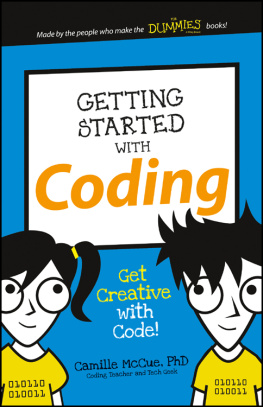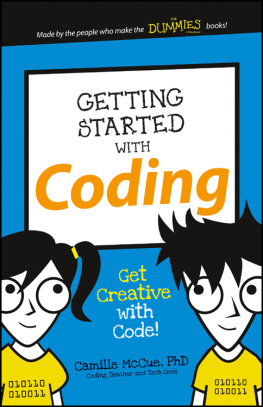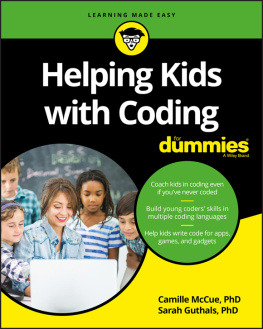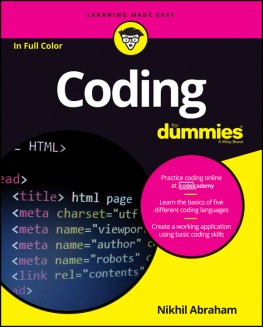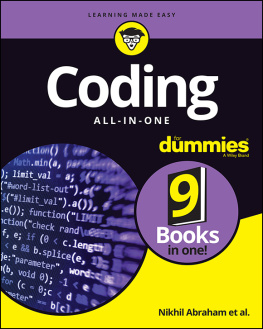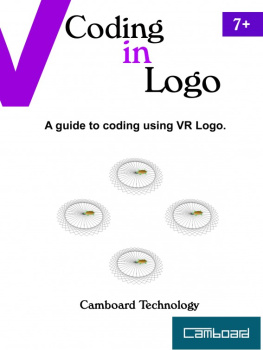Contents
List of Figures
Guide
Pagebreaks of the print version
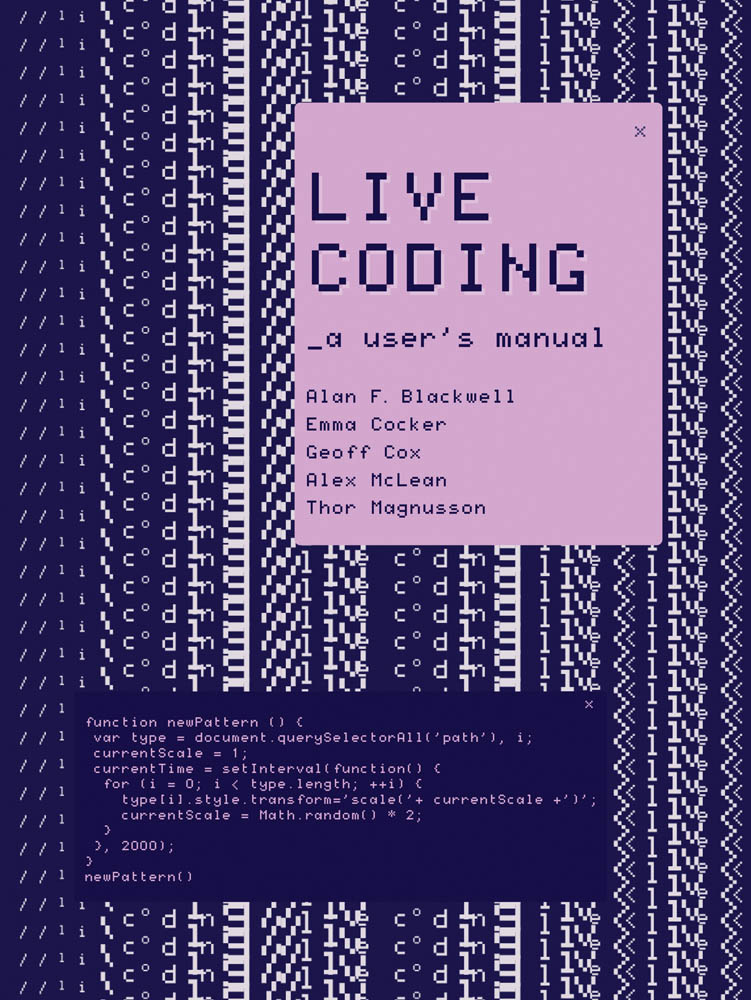
Software Studies
Lev Manovich and Noah Wardrip-Fruin, editors
Expressive Processing: Digital Fictions, Computer Games, and Software Studies, Noah Wardrip-Fruin, 2009
Code/Space: Software and Everyday Life, Rob Kitchin and Martin Dodge, 2011
Programmed Visions: Software and Memory, Wendy Hui Kyong Chun, 2011
Speaking Code: Coding as Aesthetic and Political Expression, Geoff Cox and Alex McLean, 2012
10 PRINT CHR$(205.5+RND(1)); : GOTO 10, Nick Montfort, Patsy Baudoin, John Bell, Ian Bogost, Jeremy Douglass, Mark Marino, Michael Mateas, Casey Reas, Mark Sample, and Noah Vawter, 2012
The Imaginary App, Paul D. Miller and Svitlana Matviyenko, 2014
The Stack: On Software and Sovereignty, Benjamin H. Bratton, 2015
Coding Literacy: How Computer Programming Is Changing Writing, Annette Vee, 2017
The Software Arts, Warren Sack, 2019
Critical Code Studies, Mark C. Marino, 2020
How Pac-Man Eats, Noah Wardrip-Fruin, 2020
Live Coding: A Users Manual, Alan F. Blackwell, Emma Cocker, Geoff Cox, Alex McLean, and Thor Magnusson, 2022
Live Coding
A Users Manual
Alan F. Blackwell, Emma Cocker, Geoff Cox, Alex McLean, and Thor Magnusson
The MIT Press
Cambridge, Massachusetts
London, England
2022 Massachusetts Institute of Technology
This work is subject to a Creative Commons CC-BY-SA license.
Subject to such license, all rights are reserved.

The MIT Press would like to thank the anonymous peer reviewers who provided comments on drafts of this book. The generous work of academic experts is essential for establishing the authority and quality of our publications. We acknowledge with gratitude the contributions of these otherwise uncredited readers.
Library of Congress Cataloging-in-Publication Data
Names: Blackwell, Alan F., author. | Cocker, Emma, author. | Cox, Geoff, author. | McLean, Alex, 1975 author. | Magnusson, Thor, author.
Title: Live coding : a users manual / Alan F. Blackwell, Emma Cocker, Geoff Cox, Alex McLean, and Thor Magnusson.
Description: Cambridge, Massachusetts : The MIT Press, [2022] | Series: Software studies | Includes bibliographical references and index.
Identifiers: LCCN 2022008717 (print) | LCCN 2022008718 (ebook) | ISBN 9780262544818 (paperback) | ISBN 9780262372626 (epub) | ISBN 9780262372633 (pdf)
Subjects: LCSH: Computer programmingPhilosophy. | Agile software development. | Creation (Literary, artistic, etc.) | AlgorithmsPsychological aspects.
Classification: LCC QA76.6 .B5794 2022 (print) | LCC QA76.6 (ebook) | DDC 005.1301dc23/eng/20220527
LC record available at https://lccn.loc.gov/2022008717
LC ebook record available at https://lccn.loc.gov/2022008718
d_r0
Contents
List of Figures
The original handwritten slub Generative Manifesto
The TOPLAP logo created by Adrian Ward
Algorave logo designed by David Palmer, a spirangle based on the three-armed algorithmic structure of the Brigids cross
Rangga Aji
Rangga Aji
Alejandro Albornoz, a.k.a. co(n)de Zero, and Christian Oyarzn
Alejandro Albornoz, a.k.a. co(n)de Zero
ALGOBABEZ (Shelly Knotts and Joanne Armitage)
Rafeale Andrade
Rafeale Andrade
Jack Armitage
Computer artwork by Diego Moreira Guimares
Pietro Bapthysthe (Diego Duko and Berin)
Lina Bautista performing as Linalab
Renick Bell
Renick Bell
Ashlae Blum(e)
Alexandra Cardenas
Lucy Cheesman
Screenshot of Joana Chicau live coding visuals in a web browser
Joana Chicau
Periodic table sequencer and IBM six qubit frontend in SuperCollider
Malitzin Cortes, Generative promenade or Nightmare catcher, Modern Art Museum, Mexico City, 2019
ACI Asia Culture Center. Foodhack 2019 ISEA Korea 2019
Mamady Diarra
Mamady Diarra
Live coding performance
Jason Freeman
Flor de Fuego
Flor de Fuego
Flor de Fuego
Sarah Groff Hennigh-Palermo
Haus ++
TidalCycles code
Timo Hoogland
Timo Hoogland
Miri Kaat
Livecoding jam with Abhinay Khoparzi, Akash Sharma, and Joshua Thomas
Workshop on the Marching JS livecoding platform
Four time-lapse examples of live coded graphics
Melody Loveless and Caitlin Cawley
Mynah Marie, a.k.a. Earth to Abigail
MicoRex
MicoRex
Live coding and using charts for computer-aided composition
Livecoded Splatter in Livecodelab
Altered live coded piece
Punctual live coding language
Jonathan Reus
Jonathan Reus
Chemical Algorave
Chemical Algorave
Top image: Annotations in Gibberwocky show waveforms that are periodically sampled to generate musical patterns. Bottom image: Multiple post-processing shaders stacked in Gibber to create an abstract form
Screenshot from live coding performance INVOCACIONES
Screenshot of live coding with TidalCycles and Hydra
Kate Sicchio
th4
Anne Veinberg and Felipe Ignacio Noriega
Rodrigo Velasco (yecto)
Elizabeth Wilson
Anna Xamb
Visualization of the eight-bit registers of a Z80 microchip as it performs simple calculations, demonstrating the relationship between computation and weaving
Melody Loveless performing as part of the New York DigiAna stream, September 12, 2020
Orca live coding environment
Keep Live Coding Live sticker
Series Foreword
Software is deeply woven into contemporary lifeeconomically, culturally, creatively, politicallyin manners both obvious and nearly invisible. Yet while much is written about how software is used and the activities that it supports and shapes, thinking about software itself has remained largely technical for much of its history. Increasingly, however, artists, scientists, engineers, hackers, designers, and scholars in the humanities and social sciences are finding that for the questions they face, and the things they need to build, an expanded understanding of software is necessary. For such understanding they can call upon a strand of texts in the history of computing and new media, they can take part in the rich implicit culture of software, and they can also take part in the development of an emerging, fundamentally transdisciplinary, computational literacy. These provide the foundation for Software Studies.
Software Studies uses and develops cultural, theoretical, and practice-oriented approaches to make critical, historical, and experimental accounts of (and interventions via) the objects and processes of software. The field engages and contributes to the research of computer scientists, the work of software designers and engineers, and the creations of software artists. It tracks how software is substantially integrated into the processes of contemporary culture and society, reformulating processes, ideas, institutions, and cultural objects around their closeness to algorithmic and formal description and action. Software Studies proposes histories of computational cultures and works with the intellectual resources of computing to develop reflexive thinking about its entanglements and possibilities. It does this both in the scholarly modes of the humanities and social sciences and in the software creation/research modes of computer science, the arts, and design.




